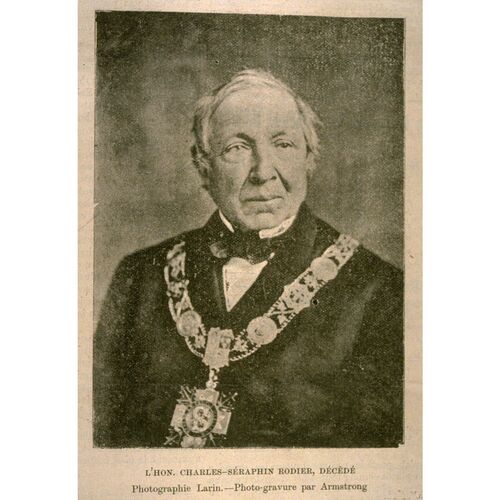RODIER, CHARLES-SÉRAPHIN (baptized Séraphin; he added Jr to his name to distinguish himself from his uncle, Charles-Séraphin Rodier*), industrialist, financier, landowner, and politician; b. 6 Oct. 1818 in Montreal, Lower Canada, son of Jean-Baptiste Rodier, a baker, and Marie-Desanges Sedillot, dit Montreuil; m. 18 Jan. 1848 Angélique Meunier, dit Lapierre, and they had 12 children; d. 26 Jan. 1890 in his native city.
Little is known about Charles-Séraphin Rodier’s youth. At the age of 14 he was working as a carpenter, and four years later he had become a building contractor. It was probably not until 1859 that he set up his factory for making agricultural implements on Rue Saint-Martin in Montreal. He produced threshing-machines which he sold to local farmers, and he demanded mortgages on their lands as security. His undertaking appears to be representative of an early stage in industrial development, that of factory production: artisans were hired on contract and paid by the job, and there was little division of labour.
Holding mortgages on his debtors’ lands and investing heavily in property, Rodier became the largest individual landowner in the Montreal region. In 1881 Le Monde declared: “He has more than half a million dollars’ worth of real estate in the town, not to mention numerous properties in suburban municipalities and in the country.”
The financial sector also interested him. In 1861, with Jean-Louis Beaudry, André Lapierre, Hubert Paré*, and Romuald Trudeau, he founded the Banque Jacques-Cartier, serving as a director until 1870, and then as vice-president from 1870 to 1876. He was its principal shareholder, and is said to have lost about $145,000 in 1876 when the bank encountered financial difficulties; after this unfortunate occurrence he resigned. Subsequently he sat on the boards of directors of the Scottish Commercial Life Insurance Company and the Mutual Life Insurance Company.
Rodier had a brief political career, as town councillor of Saint-Antoine Ward in Montreal from 1847 to 1850. He was a member of the Conservative party and “was the close friend and favourite adviser” of Sir George-Étienne Cartier*. In 1888 Conservative newspapers recalled that in 1885, at the time of the Louis Riel affair, he had remained loyal to the Conservative cabinet, and had firmly opposed the meeting on the Champ-de-Mars in Montreal. On 1 Dec. 1888 he was appointed to the Senate as representative for the division of Mille-Isles, an honour he had allegedly declined on two or three previous occasions.
Like the majority of businessmen in that period, Rodier took an active part in various associations. He was a churchwarden, president of the Association Saint-Jean-Baptiste and the St Vincent de Paul Society of Montreal, and a supporter of temperance campaigns. In addition, his large fortune enabled him to be a philanthropist. In 1869 he formed the 64th militia battalion (Voltigeurs de Beauharnois), becoming its first lieutenant-colonel.
Of humble origins, Charles-Séraphin Rodier was highly successful in business and by the end of his life had become the richest French Canadian of his day. At his death, newspapers estimated his fortune at more than $2,000,000. In the eyes of his contemporaries he was a self-made man, an illustration of the success stories that filled North American newspapers. Rodier’s career is significant on two counts. He was a representative of those French Canadians of the bourgeoisie who, from the mid 19th century, succeeded in playing an active role in the economic development of the province of Quebec. La Presse said: “He was one of those superior men who have proved the aptitude of our race for business, and who have given it its rightful place among our enterprising fellow-citizens of English origin.” Active in industry, finance, and landownership, as well as participating in political life and in various associations, Rodier exemplified the diversity of interests that still characterized businessmen in the second half of the 19th century.
[Charles-Séraphin Rodier is mentioned in the lists of shareholders of chartered banks published in Can., Parl., Sessional papers, for some of the years from 1868 to 1877. There are Rodier family papers in the possession of Mme François Hone (Montreal). p.-a.l.]
AP, Notre-Dame de Montréal, Reg. des baptêmes, manages et sépultures, 1818, 1848, 1890. BNQ, mss-100. L’Étendard, 5 déc. 1888, 27 janv. 1890. Gazette (Montréal), 27 janv. 1890. La Minerve, 28 nov., 4 déc. 1888; 28 janv. 1890. Le Monde, 7 déc. 1888. Montreal Daily Witness, 27 Jan. 1890. La Patrie, 27 janv. 1890. La Presse, 12 déc. 1888; 27, 28 janv. 1890. CPC, 1889. J. Desjardins, Guide parl., 252. Montreal directory, 1853–60. Atherton, Montreal, III: 85–86. Histoire de la corporation de la cité de Montréal depuis son origine jusqu’à nos jours . . . , J.-C. Lamothe et al., édit. (Montréal, 1903). Rumilly, Hist. de Montréal, III. É.-Z. Massicotte, “Deux Rodier,” BRH, 44 (1938): 120–22.
Cite This Article
Paul-André Linteau, “RODIER, CHARLES-SÉRAPHIN (baptized Séraphin) (1818-90),” in Dictionary of Canadian Biography, vol. 11, University of Toronto/Université Laval, 2003–, accessed January 1, 2026, https://www.biographi.ca/en/bio/rodier_charles_seraphin_1818_90_11E.html.
The citation above shows the format for footnotes and endnotes according to the Chicago manual of style (16th edition). Information to be used in other citation formats:
| Permalink: | https://www.biographi.ca/en/bio/rodier_charles_seraphin_1818_90_11E.html |
| Author of Article: | Paul-André Linteau |
| Title of Article: | RODIER, CHARLES-SÉRAPHIN (baptized Séraphin) (1818-90) |
| Publication Name: | Dictionary of Canadian Biography, vol. 11 |
| Publisher: | University of Toronto/Université Laval |
| Year of publication: | 1982 |
| Year of revision: | 1982 |
| Access Date: | January 1, 2026 |


![L'honorable Charles-Séraphin Rodier, décédé [image fixe] / Henri et Armstrong Larin Original title: L'honorable Charles-Séraphin Rodier, décédé [image fixe] / Henri et Armstrong Larin](/bioimages/w600.5015.jpg)

